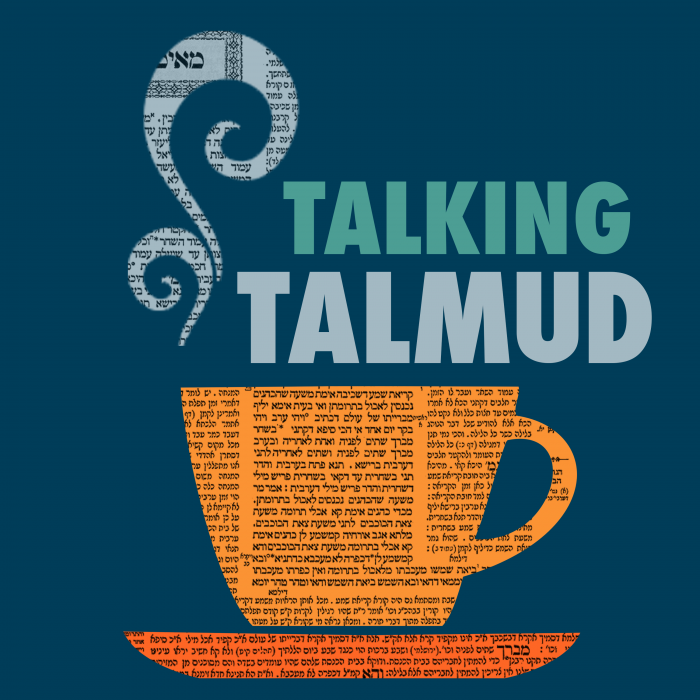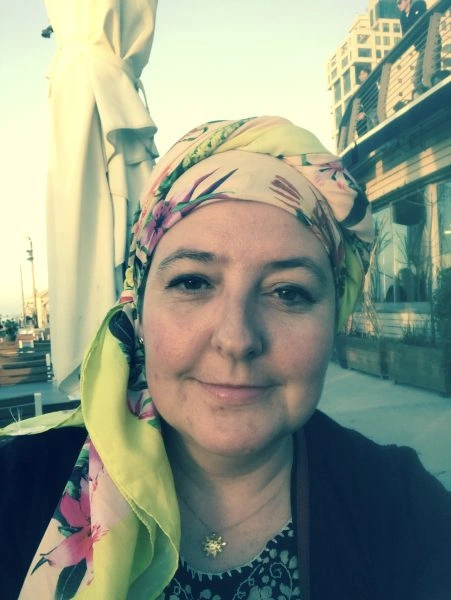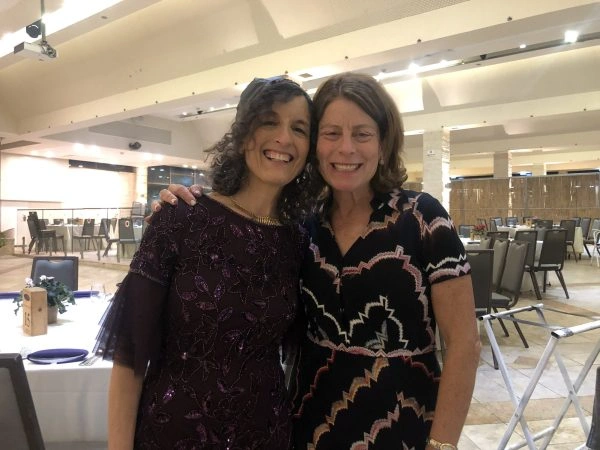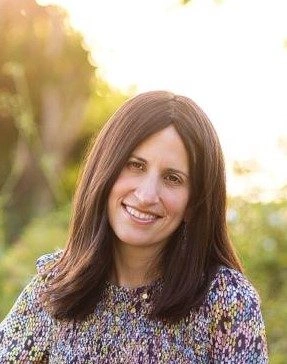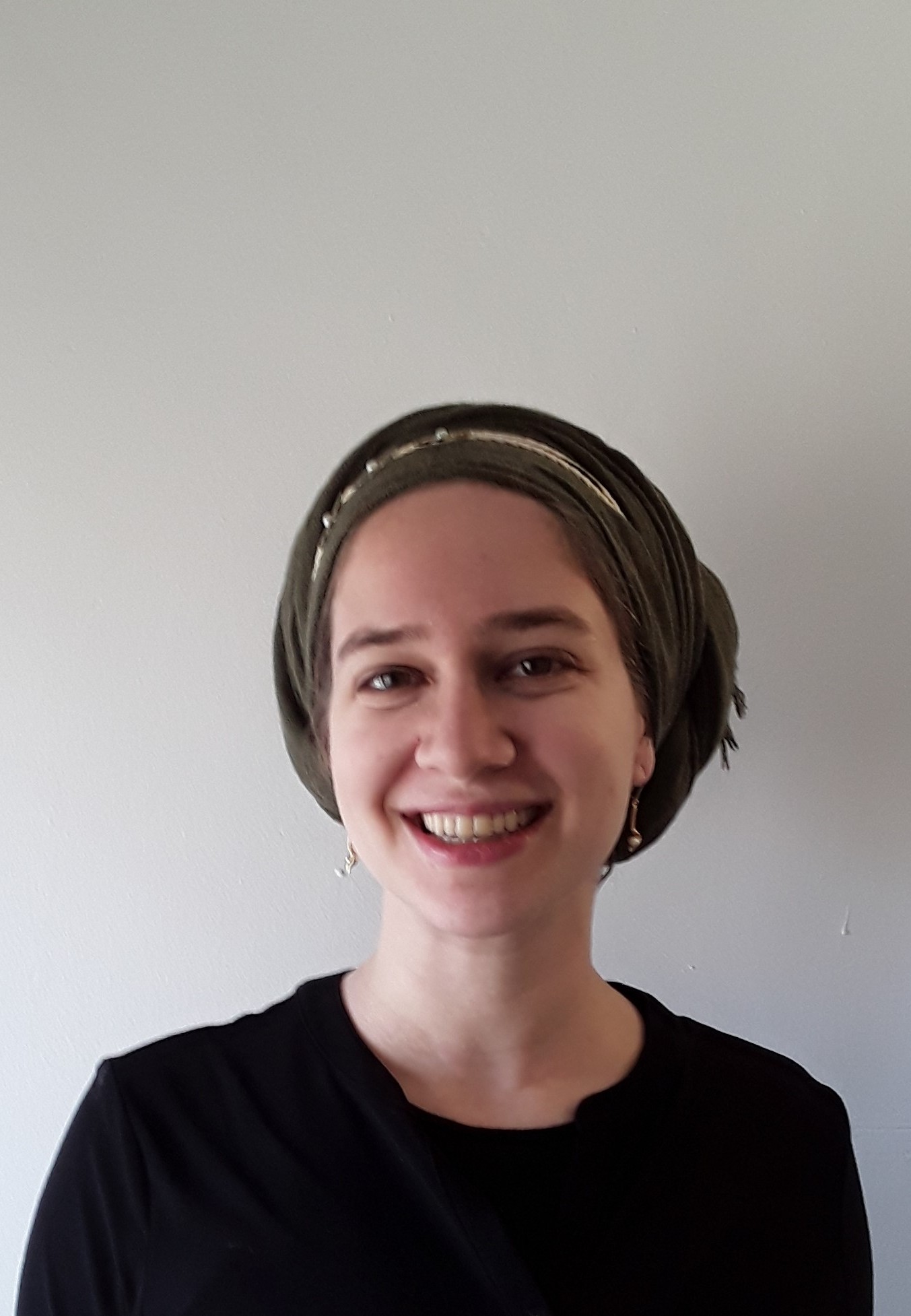Sanhedrin 45
גְּמָ׳ תָּנוּ רַבָּנַן: הָאִישׁ מְכַסִּין אוֹתוֹ פֶּרֶק אֶחָד מִלְּפָנָיו, וְאִשָּׁה שְׁנֵי פְּרָקִים – בֵּין מִלְּפָנֶיהָ בֵּין מִלְּאַחֲרֶיהָ, מִפְּנֵי שֶׁכּוּלָּהּ עֶרְוָה. דִּבְרֵי רַבִּי יְהוּדָה. וַחֲכָמִים אוֹמְרִים: הָאִישׁ נִסְקָל עָרוֹם, וְאֵין הָאִשָּׁה נִסְקֶלֶת עֲרוּמָּה.
GEMARA: The mishna teaches that a man is stoned naked but a woman is not stoned naked. With regard to this matter the Sages taught a related baraita: They cover a man’s genitals with one piece of cloth in the front, and a woman is covered with two pieces of cloth, both in the front and in the back, because all of that area is nakedness, which may not be viewed. This is the statement of Rabbi Yehuda. But the Rabbis say: A man is stoned naked, but a woman is not stoned naked.
מַאי טַעְמַיְיהוּ דְּרַבָּנַן? אָמַר קְרָא: ״וְרָגְמוּ אֹתוֹ״. מַאי ״אוֹתוֹ״?
The Gemara asks: What is the reasoning behind the opinion of the Rabbis, who say that a man is stoned naked, but a woman is not? The Gemara answers: The verse states: “And all the congregation shall stone him” (Leviticus 24:14). What does the verse intend to teach when it emphasizes that they stone “him”?
אִילֵּימָא אוֹתוֹ וְלֹא אוֹתָהּ, וְהָכְתִיב: ״וְהוֹצֵאתָ אֶת הָאִישׁ הַהוּא אוֹ אֶת הָאִשָּׁה הָהִיא״? אֶלָּא מַאי ״אוֹתוֹ״? אוֹתוֹ בְּלֹא כְּסוּתוֹ, הָא אוֹתָהּ בִּכְסוּתָהּ. רַבִּי יְהוּדָה אוֹמֵר: אוֹתוֹ בְּלֹא כְּסוּתוֹ, לָא שְׁנָא אִישׁ וְלָא שְׁנָא אִשָּׁה.
If we say that this serves to teach that they stone only him, the man, but not her, i.e., women are not punished with stoning, there is a difficulty. As isn’t it written explicitly: “And you shall bring forth that man or that woman…and stone them with stones until they die” (Deuteronomy 17:5)? Rather, what does the verse mean to teach when it stresses that they stone “him”? If he is a man, they stone just him, without his clothes, but if the condemned party is a woman, they stone her with her clothing. Rabbi Yehuda says: The emphasis on the word “him” teaches that they stone him alone, i.e., without his clothes, but as is the case with all other punishments stated in the Torah, there is no difference for a man and no difference for a woman, meaning the same halakha applies to both men and women.
לְמֵימְרָא דְּרַבָּנַן חָיְישִׁי לְהִרְהוּרָא, וְרַבִּי יְהוּדָה לָא חָיֵישׁ לְהִרְהוּרָא? וְהָא אִיפְּכָא שְׁמַעְנָא לְהוּ, דִּתְנַן: הַכֹּהֵן אוֹחֵז בִּבְגָדֶיהָ – אִם נִקְרְעוּ נִקְרְעוּ, וְאִם נִפְרְמוּ נִפְרְמוּ, עַד שֶׁמְּגַלֶּה אֶת לִבָּהּ וְסוֹתֵר אֶת שְׂעָרָהּ. רַבִּי יְהוּדָה אוֹמֵר: אִם הָיָה לִבָּהּ נָאֶה לֹא הָיָה מְגַלֵּהוּ, וְאִם הָיָה שְׂעָרָהּ נָאֶה לֹא הָיָה סוֹתְרוֹ.
The Gemara asks: Is this to say that the Rabbis are concerned that the sight of a naked woman will arouse sexual thoughts among the onlookers, and Rabbi Yehuda is not concerned about such sexual thoughts? But didn’t we hear them say just the opposite, as we learned in a mishna (Sota 7a) with regard to a sota, a woman suspected of adultery by her husband, and who was made to undergo the ordeal of the bitter waters: And the priest grabs hold of her clothing and pulls it, without concern about what happens to it. If the clothes are torn, they are torn; if the stitches come apart, they come apart. And he pulls her clothing until he reveals her heart, i.e., her chest. And then he unbraids her hair. Rabbi Yehuda says: If her heart was attractive he would not reveal it, and if her hair was attractive he would not unbraid it. This seems to indicate that it is Rabbi Yehuda who is concerned about the sexual thoughts of the onlookers.
אָמַר רַבָּה: הָתָם הַיְינוּ טַעְמָא, שֶׁמָּא תֵּצֵא מִבֵּית דִּין זַכָּאָה וְיִתְגָּרוּ בָּהּ פִּירְחֵי כְּהוּנָּה. הָכָא הָא מִקַּטְלָא. וְכִי תֵּימָא: אָתֵי לְאִיתְגָּרוֹיֵי בְּאַחְרָנְיָיתָא? אָמַר רַבָּה: גְּמִירִי, אֵין יֵצֶר הָרָע שׁוֹלֵט אֶלָּא בְּמִי שֶׁעֵינָיו רוֹאוֹת.
Rabba said: There, in the case of a sota, this is the reason that Rabbi Yehuda says that the priest does not reveal the woman’s chest or unbraid her hair: Perhaps the sota will leave the court having been proven innocent, and the young priests in the Temple who saw her partially naked will become provoked by the sight of her. Here, in the case of a woman who is stoned, she is killed by being stoned, and there is no concern about the onlookers’ becoming provoked after her death. The Gemara comments: And if you would say that the fact that she is killed is irrelevant to their having sexual thoughts because the onlookers will be provoked with regard to other women, this is not a concern, as Rabba says: It is learned as a tradition that the evil inclination controls only that which one’s eyes see.
אָמַר רָבָא: דְּרַבִּי יְהוּדָה אַדְּרַבִּי יְהוּדָה קַשְׁיָא, דְּרַבָּנַן אַדְּרַבָּנַן לָא קַשְׁיָא? אֶלָּא אָמַר רָבָא: דְּרַבִּי יְהוּדָה אַדְּרַבִּי יְהוּדָה לָא קַשְׁיָא, כִּדְשַׁנִּין.
Rava says: Is the contradiction between one statement of Rabbi Yehuda and the other statement of Rabbi Yehuda difficult, while the contradiction between one statement of the Rabbis and the other statement of the Rabbis is not difficult? There is also an apparent contradiction between the two rulings of the Rabbis, as with regard to a sota, they are not concerned about sexual thoughts, but with regard to a woman who is stoned they are concerned. Rather, Rava says: The contradiction between one statement of Rabbi Yehuda and the other statement of Rabbi Yehuda is not difficult, as we answered above.
דְּרַבָּנַן אַדְּרַבָּנַן נָמֵי לָא קַשְׁיָא. אָמַר קְרָא: ״וְנִוַּסְּרוּ כׇּל הַנָּשִׁים וְלֹא תַעֲשֶׂינָה כְּזִמַּתְכֶנָה״. הָכָא, אֵין לְךָ יִיסּוּר גָּדוֹל מִזֶּה.
Rava continues: The contradiction between one ruling of the Rabbis and the other ruling of the Rabbis is not difficult either. With regard to a sota, the verse states that other women should be warned: “Thus will I cause lewdness to cease out of the land, that all women may be chastened not to do like your lewdness” (Ezekiel 23:48). In order to serve as an example and warning to other women, a woman suspected of adultery must undergo public disgrace, and therefore the concern about the sexual thoughts that her partially naked body might arouse is disregarded. Here, with regard to stoning, you have no chastening greater than seeing this stoning itself.
וְכִי תֵּימָא: לֶיעְבֵּיד בַּהּ תַּרְתֵּי? אָמַר רַב נַחְמָן אָמַר רַבָּה בַּר אֲבוּהּ: אָמַר קְרָא ״וְאָהַבְתָּ לְרֵעֲךָ כָּמוֹךָ״ – בְּרוֹר לוֹ מִיתָה יָפָה.
And if you would say that two forms of chastening, both stoning and humiliation, should be done to her, Rav Naḥman says that Rabba bar Avuh says: The verse states: “You shall love your neighbor as yourself” (Leviticus 19:18), teaching that even with regard to a condemned prisoner, select a good, i.e., a compassionate, death for him. Therefore, when putting a woman to death by stoning, she should not be humiliated in the process.
לֵימָא: דְּרַב נַחְמָן תַּנָּאֵי הִיא? לָא, דְּכוּלֵּי עָלְמָא אִית לְהוּ דְּרַב נַחְמָן, וְהָכָא בְּהָא קָמִיפַּלְגִי: מָר סָבַר בִּזְיוֹנֵי דְאִינִישׁ עֲדִיף לֵיהּ טְפֵי מִנְּיָחָא דְגוּפֵיהּ, וּמָר סָבַר נְיָחָא דְגוּפֵיהּ עֲדִיף מִבִּזְיוֹנֵיהּ.
The Gemara suggests: Let us say that whether one rules in accordance with the statement of Rav Naḥman is a dispute between tanna’im, and according to Rabbi Yehuda there is no mitzva to select a compassionate death. The Gemara refutes this: No, it may be that everyone agrees with the opinion of Rav Naḥman, and here they disagree about this: One Sage, i.e., the Rabbis, holds: Minimizing one’s degradation is better for him than seeing to his physical comfort, i.e., than minimizing his physical pain. Therefore, the Rabbis view the more compassionate death as one without degradation, even if wearing clothes will increase the pain of the one being executed, as the clothes will absorb the blow and prolong his death. And one Sage, Rabbi Yehuda, holds that one’s physical comfort is better for him than minimizing his degradation, and therefore the one being executed prefers to be stoned unclothed, without any chance of the clothing prolonging his death, even though this increases his degradation.
מַתְנִי׳ בֵּית הַסְּקִילָה הָיָה גָּבוֹהַּ שְׁתֵּי קוֹמוֹת. אֶחָד מִן הָעֵדִים דּוֹחֲפוֹ עַל מׇתְנָיו. נֶהְפַּךְ עַל לִבּוֹ, הוֹפְכוֹ עַל מׇתְנָיו. וְאִם מֵת בָּהּ – יָצָא.
MISHNA: The place of stoning from which the condemned man is pushed to his death is a platform twice the height of an ordinary person. He is made to stand at the edge of the platform, and then one of the witnesses who testified against him pushes him down by the hips, so that he falls face up onto the ground. If he turned over onto his chest, with his face downward, the witness turns him over onto his hips. And if he dies through this fall to the ground, the obligation to stone the transgressor is fulfilled.
וְאִם לָאו, הַשֵּׁנִי נוֹטֵל אֶת הָאֶבֶן וְנוֹתְנוֹ עַל לִבּוֹ. אִם מֵת בָּהּ – יָצָא, וְאִם לָאו – רְגִימָתוֹ בְּכׇל יִשְׂרָאֵל, שֶׁנֶּאֱמַר: ״יַד הָעֵדִים תִּהְיֶה בּוֹ בָרִאשׁוֹנָה לַהֲמִיתוֹ וְיַד כׇּל הָעָם בָּאַחֲרוֹנָה״.
And if the condemned man does not die from his fall, the second witness takes the stone that has been prepared for this task and places, i.e., casts, it on his chest. And if he dies with the casting of this first stone, the obligation to stone the transgressor is fulfilled. And if he does not die with the casting of this stone, then his stoning is completed by all of the Jewish people, i.e., by all the people who assembled for the execution, as it is stated: “The hand of the witnesses shall be first upon him to put him to death, and afterward the hand of all the people” (Deuteronomy 17:7).
גְּמָ׳ תָּנָא: וְקוֹמָה שֶׁלּוֹ, הֲרֵי כָּאן שָׁלֹשׁ. וּמִי בָּעֵינַן כּוּלֵּי הַאי? וּרְמִינְהוּ: מָה בּוֹר שֶׁהוּא כְּדֵי לְהָמִית – עֲשָׂרָה טְפָחִים, אַף כֹּל כְּדֵי לְהָמִית – עֲשָׂרָה טְפָחִים.
GEMARA: A tanna taught in a baraita: Adding together the height of the platform, which is twice the height of an ordinary person, and the condemned man’s own height, it turns out that there is a height here three times the height of an ordinary person. The Gemara asks: Do we really need all that height to kill him? The Gemara raises a contradiction to the baraita from what was taught in a mishna (Bava Kamma 50b) when discussing the halakhot of damage caused by a pit: Why does the Torah specify a pit when one is liable for the damage caused by any type of excavation that he digs into the ground? This teaches that just as a pit that is of sufficient depth to cause one’s death from falling into it is at least ten handbreadths deep, so too, any other excavations that are of sufficient depth to cause one’s death may be no less than ten handbreadths. If a fall of ten handbreadths is sufficient to kill a person, why must the platform from which the condemned man is pushed be twice the height of an ordinary person?
אָמַר רַב נַחְמָן אָמַר רַבָּה בַּר אֲבוּהּ: אָמַר קְרָא ״וְאָהַבְתָּ לְרֵעֲךָ כָּמוֹךָ״, בְּרוֹר לוֹ מִיתָה יָפָה. אִי הָכִי, לַיגְבְּהֵיהּ טְפֵי! מִשּׁוּם דְּמִינַּוַּל.
Rav Naḥman says that Rabba bar Avuh says: The verse states: “You shall love your neighbor as yourself” (Leviticus 19:18), teaching that even with regard to a condemned man, select a good, i.e., a compassionate, death for him. Therefore, even though the one being executed is likely to die from a fall from a lesser height, a platform is built that is twice the height of an ordinary person in order to ensure a quick and relatively painless death. The Gemara challenges: If so, they should raise the platform even higher. The Gemara answers: This is not done, because if the condemned man were pushed from a higher platform, he would become seriously disfigured, and this would no longer be considered a compassionate form of death.
אֶחָד מִן הָעֵדִים דּוֹחֲפוֹ. תָּנוּ רַבָּנַן: מִנַּיִין שֶׁבִּדְחִיָּיה? תַּלְמוּד לוֹמַר ״יָרֹה״. וּמִנַּיִן שֶׁבִּסְקִילָה? תַּלְמוּד לוֹמַר ״סָקוֹל״.
§ The mishna teaches that one of the witnesses who had testified against the condemned party pushes him off the platform. Concerning this halakha the Sages taught in a baraita: From where is it derived that the punishment of stoning can be fulfilled by pushing the condemned party from a high place, so that he dies from his fall? The verse states with regard to those who crossed the boundaries that were set up around Mount Sinai and touched the mountain: “Take heed to yourselves, that you not go up into the mountain, or touch the border of it; whoever touches the mountain shall be put to death; no hand shall touch him, but he shall be stoned or shall be thrown down” (Exodus 19:12–13). And from where is it derived that this punishment can be fulfilled with actual stoning? The verse states: “He shall be stoned.”
וּמִנַּיִן שֶׁבִּסְקִילָה וּבִדְחִיָּיה? תַּלְמוּד לוֹמַר: ״סָקוֹל יִסָּקֵל אוֹ יָרֹה יִיָּרֶה״. וּמִנַּיִן שֶׁאִם מֵת בִּדְחִיָּיה יָצָא? תַּלְמוּד לוֹמַר: ״אוֹ יָרֹה יִיָּרֶה״. מִנַּיִין שֶׁאַף לְדוֹרוֹת כֵּן?
And from where is it derived that this punishment is sometimes fulfilled both by stoning and by pushing, i.e., if the transgressor did not die from his fall, he is then stoned? The verse states: “He shall be stoned or shall be thrown down.” And from where is it derived that if the condemned man died from the pushing, the obligation to stone him has been fulfilled, and there is no further need to actually stone him? The verse states: “Or shall be thrown down,” with the term “or” indicating that only one of the two options must be fulfilled. And from where is it derived that this is the halakha not only at Mount Sinai, but even with regard to future generations?
תַּלְמוּד לוֹמַר: ״סָקוֹל יִסָּקֵל״.
The verse states: “He shall be stoned [sakol yissakel ],” with the doubled verb form indicating that the halakha applies in all places and at all times.
וְאִם לָאו, עֵד הַשֵּׁנִי נוֹטֵל אֶת הָאֶבֶן. נוֹטֵל? וְהָתַנְיָא: רַבִּי שִׁמְעוֹן בֶּן אֶלְעָזָר אוֹמֵר, אֶבֶן הָיְתָה שָׁם מַשּׂוֹי שְׁנֵי בְּנֵי אָדָם, נוֹטְלָהּ וְנוֹתְנָהּ עַל לִבּוֹ. אִם מֵת בָּהּ – יָצָא. וְלִיטַעְמָיךְ, תִּיקְשֵׁי לָךְ הִיא גּוּפַהּ: מַשּׂוֹי שְׁנֵי בְּנֵי אָדָם, נוֹטְלָהּ וְנוֹתְנָהּ עַל לִבּוֹ?
§ The mishna teaches that if the condemned party does not die from his fall, the second witness takes the stone that had been prepared for this task and casts it on his chest. The Gemara asks: Does the witness take the stone by himself? But isn’t it taught in a baraita that Rabbi Shimon ben Elazar says: A stone was there with a weight that could be lifted only by two men. The witness takes it and places, i.e., casts, it on the condemned party’s chest. If he dies with the casting of this stone, the obligation to stone the transgressor is fulfilled. This indicates that one individual could not lift the stone by himself. The Gemara answers: And according to your reasoning, the baraita itself should pose a difficulty for you, as it first states that the stone was of a weight that could be lifted only by two men, and then it says that the witness takes it and places it on the condemned party’s chest, apparently acting alone.
אֶלָּא, דְּמַדְלֵי לַהּ בַּהֲדֵי חַבְרֵיהּ, וְשָׁדֵי לַהּ אִיהוּ, כִּי הֵיכִי דְּתֵיתֵי מֵרַזְיָא.
Rather, both the mishna and the baraita should be explained as follows: The second witness lifts the stone together with the other witness, but then the second witness alone casts it so that it should fall with force upon the condemned party’s chest, as two people working together cannot aim their throw with precision.
וְאִם לָאו, רְגִימָתוֹ כּוּ׳. וְהָתַנְיָא: מֵעוֹלָם לֹא שָׁנָה בָּהּ אָדָם! מִי קָאָמֵינָא דְּעָבֵיד? דְּאִי מִצְּרִיךְ קָאָמֵינָא.
The mishna teaches: And if the condemned party does not die with the first stone, then his stoning is completed by all of the Jewish people. The Gemara raises a difficulty: But isn’t it taught in a baraita: Never did a person repeat the stoning, as the condemned party always died with the first stone cast upon him? The Gemara answers: Did we say that they acted so? Rather, we said that if the condemned party did not die with the casting of the first stone and it was necessary to try again, the stoning is completed by all of the people who assembled for the execution.
אָמַר מָר: אֶבֶן הָיְתָה כּוּ׳. וְהָתַנְיָא: אַחַת אֶבֶן שֶׁנִּסְקָל בָּהּ, וְאַחַת עֵץ שֶׁנִּתְלֶה עָלָיו, וְאֶחָד סַיִיף שֶׁנֶּהֱרָג בּוֹ, וְאֶחָד סוּדָר שֶׁנֶּחְנָק בּוֹ – כּוּלָּן נִקְבָּרִין עִמּוֹ. לָא צְרִיכָא דִּמְתַקְּנִי וּמַיְיתִי אַחֲרִינֵי חִלּוּפַיְיהוּ.
The Master said in the baraita that a stone was there, indicating that a special stone was kept in the place of stoning and used time and time again for this purpose. The Gemara asks: But isn’t it taught in a baraita: The stone with which the condemned party was stoned and the tree on which his corpse was hung, or the sword with which he was killed, or the cloth with which he was strangled, all of them are buried together with him? If so, the same stone could not have been used for every execution. The Gemara answers: No, it is necessary to teach that after the stones were buried with the transgressor, they would prepare other stones and bring them to the place of stoning in their place.
נִקְבָּרִין עִמּוֹ. וְהָתַנְיָא: אֵין נִקְבָּרִין עִמּוֹ? אָמַר רַב פָּפָּא: מַאי ״עִמּוֹ״? עִמּוֹ בִּתְפִיסָתוֹ.
The baraita teaches that all of the items used in the execution are buried together with the transgressor. The Gemara asks: But isn’t it taught in another baraita that they are not buried together with the transgressor? Rav Pappa said: What does the baraita mean when it says that these items are buried together with him? They are not actually buried together with him in the same grave; rather, they are buried within his grasp, i.e., in the area surrounding his grave.
אָמַר שְׁמוּאֵל: נִקְטְעָה יַד הָעֵדִים – פָּטוּר. מַאי טַעְמָא? דְּבָעֵינָא ״יַד הָעֵדִים תִּהְיֶה בּוֹ בָרִאשׁוֹנָה,״ וְלֵיכָּא.
§ Shmuel says: If the witnesses’ hands were severed after the transgressor was sentenced to be stoned, so that they can no longer stone him themselves, the transgressor is exempt from punishment and is not executed. What is the reason for this? This is because I need to fulfill what is stated in the verse: “The hand of the witnesses shall be first upon him to put him to death” (Deuteronomy 17:7), and here this is not possible.
אֶלָּא מֵעַתָּה, עֵדִים גִּידְמִין דְּמֵעִיקָּרָא, הָכִי נָמֵי דִּפְסִילִי? שָׁאנֵי הָתָם, דְּאָמַר קְרָא: ״יַד הָעֵדִים״, שֶׁהָיְתָה כְּבָר.
The Gemara asks: If that is so, that the witnesses themselves must stone the transgressor or else the sentence is not carried out, if the witnesses lacked hands from the outset, when they offered their testimony, are they also disqualified? The Gemara answers: There it is different, as the verse states: “The hand of the witnesses,” indicating that the hands that were there already when the witnesses gave their testimony must throw the first stone when the transgressor is executed. If the witnesses already lacked hands at the time of their testimony, others can throw the first stone.
מֵיתִיבִי: כׇּל מָקוֹם שֶׁיְּעִידוּהוּ שְׁנַיִם וְיֹאמְרוּ, ״מְעִידִין אָנוּ בְּאִישׁ פְּלוֹנִי שֶׁנִּגְמַר דִּינוֹ בְּבֵית דִּין פְּלוֹנִי, וּפְלוֹנִי וּפְלוֹנִי עֵדָיו״ – הֲרֵי זֶה יֵהָרֵג. תַּרְגְּמָא שְׁמוּאֵל בְּ״הֵּן הֵן עֵדָיו״.
The Gemara raises an objection to the opinion of Shmuel from what is taught in a mishna (Makkot 7a): In any place where two witnesses testify before a court and say: We testify about so-and-so that his death sentence was issued in such and such a court, and so-and-so and so-and-so were his witnesses, he is executed, and there is no need to retry him. This seems to indicate that the transgressor is put to death even if the witnesses are not there to throw the first stone. The Gemara explains: Shmuel interpreted the mishna as referring to a case where the witnesses who testify about the transgressor’s conviction in a different court are the same witnesses who had testified against him at his original trial, and they are present to throw the first stone.
וּמִי בָּעֵינַן קְרָא כְּדִכְתִיב? וְהָתַנְיָא: ״מוֹת יוּמַת הַמַּכֶּה רוֹצֵחַ הוּא״ – אֵין לִי אֶלָּא בְּמִיתָה הַכְּתוּבָה בּוֹ. מִנַּיִן שֶׁאִם אִי אַתָּה יָכוֹל לַהֲמִיתוֹ בְּמִיתָה הַכְּתוּבָה בּוֹ שֶׁאַתָּה מְמִיתוֹ בְּכׇל מִיתָה שֶׁאַתָּה יָכוֹל לַהֲמִיתוֹ? תַּלְמוּד לוֹמַר: ״מוֹת יוּמַת הַמַּכֶּה״ – מִכׇּל מָקוֹם.
The Gemara raises another difficulty against the opinion of Shmuel: But do we really need to fulfill what is stated in the verse exactly as it is written? But isn’t it taught in a baraita: The verse with regard to a murderer states: “He that smote him shall be put to death, for he is a murderer” (Numbers 35:21)? I have derived only that the murderer is put to death with the mode of execution written concerning him, i.e., decapitation. From where do I derive that if you cannot put him to death with the mode of execution written concerning him, e.g., if he is escaping from the court, you can put him to death with any mode of execution with which you can put him to death? The verse states: “He that smote him shall be put to death [mot yumat],” where the doubled verb teaches that he is put to death in any case, by any mode of execution. Here too, the condemned party should be executed even if the witnesses cannot cast the first stone.
שָׁאנֵי הָתָם, דְּאָמַר קְרָא: ״מוֹת יוּמַת״.
The Gemara answers: There, concerning a murderer, it is different, as the verse explicitly states: “He that smote him shall be put to death,” which serves to include all modes of execution.
וְלִיגְמַר מִינֵּיהּ? מִשּׁוּם דְּהָוֵה רוֹצֵחַ וְגוֹאֵל הַדָּם שְׁנֵי כְּתוּבִין הַבָּאִין כְּאֶחָד, וְכׇל שְׁנֵי כְּתוּבִין הַבָּאִין כְּאֶחָד אֵין מְלַמְּדִין.
The Gemara asks: But why not learn from this halakha a principle that can be applied in all cases of capital punishment? The Gemara responds: This case does not prove a principle, because the halakhot of the murderer and of the blood redeemer, i.e., a relative of one who was killed who takes it upon himself to redeem his relative’s death, are two verses that come as one, and the rule is that two verses that come as one do not teach a principle. In other words, if a halakha is stated in the Torah with regard to two individual cases, the halakha is understood to apply only to those cases. Had the halakha applied to all other relevant cases as well, it would not have been necessary for the Torah to teach it twice. The fact that two cases are mentioned indicates that they are the exceptions rather than the rule.
רוֹצֵחַ – הָא דַּאֲמַרַן. גּוֹאֵל הַדָּם מַאי הִיא? דְּתַנְיָא: ״גֹּאֵל הַדָּם יָמִית אֶת הָרֹצֵחַ״ – מִצְוָה בְּגוֹאֵל הַדָּם. וּמִנַּיִין שֶׁאִם אֵין לוֹ גּוֹאֵל שֶׁבֵּית דִּין מַעֲמִידִין לוֹ גּוֹאֵל? שֶׁנֶּאֱמַר: ״בְּפִגְעוֹ בּוֹ״ – מִכׇּל מָקוֹם.
The Gemara explains: The halakha that capital punishment need not necessarily be imposed in accordance with the Torah’s specific instructions is taught with regard to two cases, that of the murderer and that of the blood redeemer. The case of a murderer is this halakha that we said. With regard to the case of a blood redeemer, what is it? As it is taught in a baraita: The verse states: “The blood redeemer shall slay the murderer when he meets him” (Numbers 35:21). This mitzva of redeeming the death caused by an unintentional killer falls on the blood redeemer, a relative of the victim. And from where is it derived that if the victim has no blood redeemer the court appoints a blood redeemer for him? As it is stated: “When he meets him,” which teaches that in any case he shall slay the murderer, whether he is a relative or a court-appointed blood redeemer.
אֲמַר לֵיהּ מָר קַשִּׁישָׁא בְּרֵיהּ דְּרַב חִסְדָּא לְרַב אָשֵׁי: וּמִי לָא בָּעֵינַן קְרָא כְּדִכְתִיב? וְהָתְנַן: הָיָה אֶחָד מֵהֶן גִּידֵּם, אוֹ אִילֵּם, אוֹ חִיגֵּר, אוֹ סוֹמֵא, אוֹ חֵרֵשׁ – אֵינוֹ נַעֲשָׂה בֵּן סוֹרֵר וּמוֹרֶה.
Mar Kashisha, son of Rav Ḥisda, said to Rav Ashi: And do we not need to fulfill what is stated in the verse exactly as it is written? But didn’t we learn in a mishna (Sanhedrin 71a) with regard to a stubborn and rebellious son: If one of the boy’s parents is without a hand, or is mute, or lame, or blind, or deaf, the boy is not rendered a stubborn and rebellious son?
שֶׁנֶּאֱמַר: ״וְתָפְשׂוּ בוֹ״ – וְלֹא גִּידְמִין, ״וְהוֹצִיאוּ אֹתוֹ״ – וְלֹא חִיגְּרִין, ״וְאָמְרוּ״ – וְלֹא אִילְּמִין, ״בְּנֵנוּ זֶה״ – וְלֹא סוֹמִין, ״אֵינֶנּוּ שֹׁמֵעַ בְּקֹלֵנוּ״ – וְלֹא חֵרְשִׁין.
This halakha is derived as it is stated: “Then shall his father and his mother lay hold of him, and bring him out to the elders of his city and to the gate of his place” (Deuteronomy 21:19). This serves to teach: His father and mother “lay hold of him,” but not those without a hand who cannot grab him; “and bring him out,” but not those who are lame and cannot take him out. And it is stated: “And they shall say to the elders of his city: This our son is stubborn and rebellious; he does not obey our voice; he is a glutton and a drunkard” (Deuteronomy 21:20). This verse serves to teach: “And they shall say,” but not mute people; “this our son,” but not the blind, who cannot point to the boy; “he does not obey our voice,” but not the deaf.
מַאי טַעְמָא? לָאו מִשּׁוּם דְּבָעֵינַן קְרָא כְּדִכְתִיב? לָא, שָׁאנֵי הָתָם, דְּכוּלֵּיהּ קְרָא יַתִּירָא הוּא.
What is the reason that in all these cases the boy is not rendered a stubborn and rebellious son? Is it not because we need to fulfill what is stated in the verse exactly as it is written, and this principle should hold true with regard to other verses as well? The Gemara rejects this explanation: No, there, in the case of the stubborn and rebellious son, it is different, as the entire verse is superfluous. Therefore, all of the conditions inferred from the verse must be precisely met or else the boy cannot be rendered a stubborn and rebellious son. One cannot apply this principle to other verses.
תָּא שְׁמַע: אֵין לָהּ רְחוֹב – אֵין נַעֲשֵׂית עִיר הַנִּדַּחַת, דִּבְרֵי רַבִּי יִשְׁמָעֵאל. רַבִּי עֲקִיבָא אוֹמֵר: אֵין לָהּ רְחוֹב – עוֹשִׂין לָהּ רְחוֹב.
The Gemara suggests: Come and hear a proof from what is taught in a baraita with regard to an idolatrous city, the majority of whose inhabitants engaged in idol worship, about which the verse states: “And you shall gather all the spoil of it into the midst of the open place of the city, and shall burn with fire both the city and the entire plunder taken in it” (Deuteronomy 13:17): If the city does not have an open place, it is not rendered an idolatrous city; this is the statement of Rabbi Yishmael. Rabbi Akiva says: If it does not have an open place, they make an open place for it.
עַד כָּאן לָא פְּלִיגִי, אֶלָּא דְּמָר סָבַר: ״רְחוֹבָהּ״ דְּמֵעִיקָּרָא בָּעִינַן, וּמָר סָבַר: רְחוֹבָהּ דְּהַשְׁתָּא נָמֵי כִּדְמֵעִיקָּרָא דָּמֵי. אֲבָל דְּכוּלֵּי עָלְמָא בָּעֵינַן קְרָא כְּדִכְתִיב.
The Gemara explains: Rabbi Yishmael and Rabbi Akiva disagree only with regard to this detail, that one Sage, Rabbi Yishmael, holds that we need an open place that existed from the outset when the idolatry was committed, while the other Sage, Rabbi Akiva, holds that an open place that exists now is like an open place that existed from the outset. But everyone agrees that we need to fulfill what is stated in the verse exactly as it is written.
תַּנָּאֵי הִיא, דִּתְנַן: אֵין לוֹ בֹּהֶן יָד, בֹּהֶן רֶגֶל, אֹזֶן יָמָנִית – אֵין לוֹ טׇהֳרָה עוֹלָמִית. רַבִּי אֱלִיעֶזֶר אוֹמֵר: נוֹתֵן עַל מְקוֹמוֹ וְיוֹצֵא. רַבִּי שִׁמְעוֹן אוֹמֵר: נוֹתֵן עַל שְׂמֹאלוֹ וְיוֹצֵא.
The Gemara answers: This issue is the subject of a dispute between tanna’im. As we learned in a mishna (Nega’im 14:9) concerning the purification process of a leper, during the course of which blood and oil must be applied to his right thumb, right big toe, and right ear: If the leper has no right thumb, right big toe, or right ear, he can never attain ritual purity, as he cannot fulfill the conditions of the verse. Rabbi Eliezer says: In such a case, the priest may apply the blood and oil to the place where the missing finger, toe, or ear should have been, and the leper has thereby fulfilled his obligation. Rabbi Shimon says: The priest may apply it to his left thumb, left big toe, or left ear, and the leper has thereby fulfilled his obligation. The first tanna apparently holds that the Torah’s instructions must be fulfilled exactly as they are written, while Rabbi Eliezer and Rabbi Shimon disagree and say that when this is impossible, they are dispensable.
מַתְנִי׳ כׇּל הַנִּסְקָלִין נִתְלִין, דִּבְרֵי רַבִּי אֱלִיעֶזֶר. וַחֲכָמִים אוֹמְרִים: אֵינוֹ נִתְלֶה אֶלָּא הַמְגַדֵּף וְהָעוֹבֵד עֲבוֹדָה זָרָה.
MISHNA: The corpses of all those who are stoned are hung after their death; this is the statement of Rabbi Eliezer. And the Rabbis say: Only the corpse of the blasphemer, who has cursed God, and the corpse of the idol worshipper are hung.
הָאִישׁ תּוֹלִין אוֹתוֹ פָּנָיו כְּלַפֵּי הָעָם, וְהָאִשָּׁה פָּנֶיהָ כְּלַפֵּי הָעֵץ; דִּבְרֵי רַבִּי אֱלִיעֶזֶר. וַחֲכָמִים אוֹמְרִים: הָאִישׁ נִתְלֶה וְאֵין הָאִשָּׁה נִתְלֵית. אָמַר לָהֶן רַבִּי אֱלִיעֶזֶר: וַהֲלֹא שִׁמְעוֹן בֶּן שָׁטַח תָּלָה נָשִׁים בְּאַשְׁקְלוֹן? אָמְרוּ לוֹ: שְׁמוֹנִים נָשִׁים תָּלָה, וְאֵין דָּנִין שְׁנַיִם בְּיוֹם אֶחָד.
The corpse of a man is hung facing the people, but the corpse of a woman, out of modesty, is hung facing the tree; this is the statement of Rabbi Eliezer. And the Rabbis say: the corpse of a man is hung, but the corpse of a woman is not hung. Rabbi Eliezer said to the Rabbis: Did Shimon ben Shataḥ not hang in Ashkelon women who were found guilty of witchcraft, proving that the corpse of a woman who is executed is also hung? They said to him: No proof can be brought from here, as he hanged eighty women on that day, and the halakha is that the same court may not judge even two people charged with capital transgressions on the same day. It is therefore clear that he was not acting in accordance with Torah law, but rather his execution of the eighty women was an extraordinary punishment necessitated by unusually pressing circumstances.
גְּמָ׳ תָּנוּ רַבָּנַן: ״וְהוּמָת וְתָלִיתָ״ – יָכוֹל כׇּל הַמּוּמָתִין נִתְלִין? תַּלְמוּד לוֹמַר: ״כִּי קִלְלַת אֱלֹהִים תָּלוּי״. מָה מְקַלֵּל זֶה שֶׁבִּסְקִילָה, אַף כֹּל שֶׁבִּסְקִילָה. דִּבְרֵי רַבִּי אֱלִיעֶזֶר.
GEMARA: The mishna teaches that the corpses of all those who are killed by stoning are hung after their death. The Sages taught in a related baraita: The verse states: “And if a man has committed a sin worthy of death, and he is put to death, and you shall hang him on a tree” (Deuteronomy 21:22): One might have thought that the corpses of all those who are put to death are hung. To counter this, the verse states: “His body shall not remain all night upon the tree…for he that is hung is a curse of God” (Deuteronomy 21:23), teaching that just as the blasphemer, who is liable to be punished by stoning, is hung after his death, so too, all those who are liable to be punished by stoning are later hung, but those who are liable to be executed in other ways are not hung after their death. This is the statement of Rabbi Eliezer.
וַחֲכָמִים אוֹמְרִים: מָה מְקַלֵּל זֶה שֶׁכָּפַר בָּעִיקָּר, אַף כֹּל שֶׁכָּפַר בָּעִיקָּר.
The baraita continues: And the Rabbis say: Just as the blasphemer, who denies the principle of belief in God, is hung after his death, so too, all who deny the principle of belief in God are hung after they die. But others, even if they are liable to be punished by stoning, are not hung after they are put to death.
בְּמַאי קָא מִיפַּלְגִי? רַבָּנַן דָּרְשִׁי כְּלָלֵי וּפְרָטֵי, רַבִּי אֱלִיעֶזֶר דָּרֵישׁ רִיבּוּיֵי וּמִיעוּטֵי.
The Gemara clarifies: With regard to what do they disagree? The Rabbis interpret the verses based on the principle of generalizations and details, one of the methods by which the Torah is interpreted. And Rabbi Eliezer interprets them based on the principle of amplifications and restrictions, a different approach to biblical exegesis.
רַבָּנַן דָּרְשִׁי כְּלָלֵי וּפְרָטֵי: ״וְהוּמָת וְתָלִיתָ״ – כְּלָל, ״כִּי קִלְלַת״ – פְּרָט. אִי הֲווֹ מְקָרְבִי לַהֲדָדֵי, אָמְרִינַן: אֵין בַּכְּלָל אֶלָּא מַה שֶּׁבַּפְּרָט. הָנֵי – אִין, מִידֵּי אַחֲרִינָא – לָא.
How so? The Rabbis expound the verses based on the principle of generalizations and details. The phrase “And he is put to death, and you shall hang him” is a generalization, as no particular offense is specified. The phrase “For he that is hung is a curse of God” is a detail, as a specific transgression is mentioned. Were the generalization and the detail next to each other in the same verse, we would apply the principle of generalizations and details and say that the generalization includes only that which is stated in the detail. Therefore, this transgressor, the blasphemer, yes, his corpse is subject to being hung after he is executed, but the corpse of anyone else is not.



